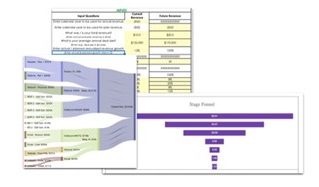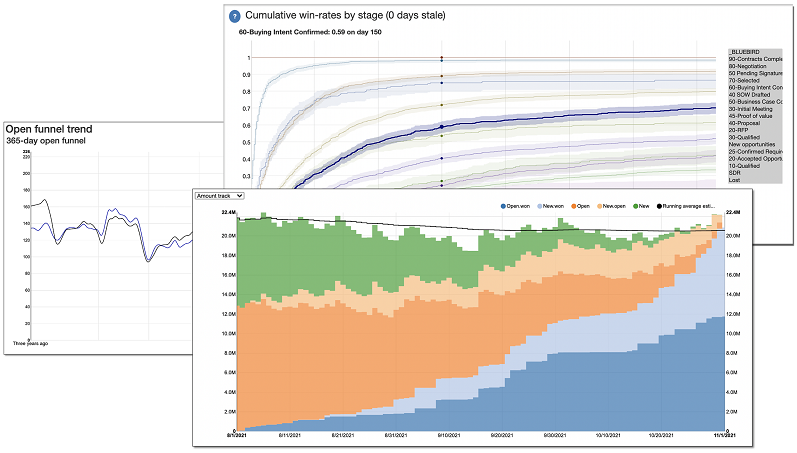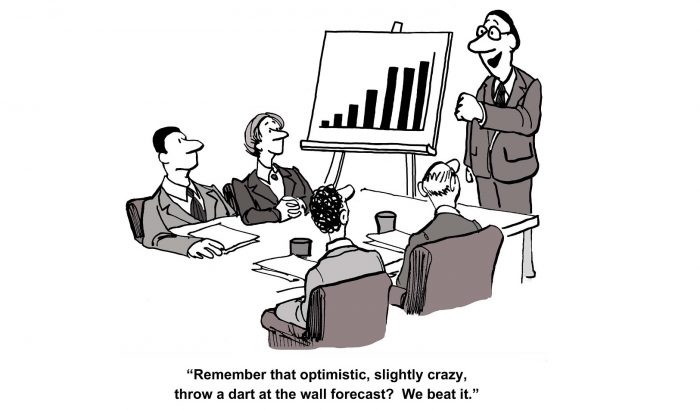Lighting Your Path: 2-Step Process for Smarter, More Accurate Revenue Forecasts
Imagine you’re on your way to meet a date at the movies. Halfway to the theater, you check the map on your phone and realize you’ve taken a wrong turn. You text your date to let them know you might be a little late. Then you use the map to find your way back to the route. When you get to the theater, maybe you’ve missed the first coming attraction, but for the most part, everything has turned out fine, and your date goes well.
Now imagine it’s a week later, and you’re meeting that same person for another date, this one at a restaurant. This time, however, your phone’s battery has died, so you’re not able to check the map to make sure you’re going the right direction. You make a wrong turn again, but by the time you realize it, you’re already two towns over from where you need to be. Desperate to make your date, you speed, run a stop sign, and make an illegal right turn on red, insisting all the while that you’ll get to the restaurant on time. It doesn’t work – by the time you find your way there, your date is on their second glass of wine, has filled up on bread and butter, and is annoyed.
We think of this story as an analogy for two common, but very different, ways that business leaders approach revenue forecasting. In one approach, Sales and Revenue executives behave like you did on your second date: They chase a revenue goal based on an initial understanding of what they’ll need to do to achieve it, but without the resources to see how they’re tracking toward that goal along the way. We call this the “cover your neck” approach – these executives know that their jobs often depend on their ability to hit their number, and so they chase it at all costs, even in the absence of data that could make it easier for them to succeed.
In the other approach – let’s call it the “light your path” approach – executives are more like you were on the first date: They understand that forecasting has to be a scientific, data-driven process, that it’s about setting expectations and reallocating resources based on real-time progress checks. These executives know that revenue forecasting becomes a lot easier when you have full visibility into:
- The lead gen resources at your disposal
- How much you’ll need to rely on each of those resources
- The budget you’ll need
- Real-world performance data you can analyze to make an informed forecast
But taking the scientific “light your path” approach isn’t exactly easy, and to the extent that executives take the “cover your neck” approach, they can’t really be blamed. Good data is hard to come by. Let’s talk about why that is, what it takes for leaders to make truly state-of-the-art sales forecasts, and how Premonio and Funnelcast deliver the one-two punch of goal-setting and historical analysis necessary to make it happen.
What’s so hard about the scientific approach?
Make no mistake: If you’re a Sales, Finance, or Revenue executive looking to align revenue forecasts with revenue actuals, the “cover-your-neck” approach is hazardous – blind faith typically leads either to underforecasting, which makes it harder to make a case to the board for more resources in the future, or overforecasting, which puts your job itself in jeopardy. The “light your path” approach is, without a doubt, the way to go. It makes your forecasts predictable, which is critical for managing cash flow and for long-term resource acquisition. But it’s also, for small- to medium-sized businesses, an uphill battle, with leaders typically running into three main challenges:
- The necessary data doesn’t exist
Making accurate long-term forecasts is a lot easier when you base those forecasts on performance trends in your historical data. That’s all well and good – unless you’re a brand new startup launching a growth plan for the first time. What if there is no historical data because you’re still in your nascent stages? What if there are no performance trends because you haven’t set them yet? It’s hard to make a data-driven revenue forecast when you have yet to generate any actual, you know – data. - The data exists – but it’s lousy
Even if you’ve been around the block a few times and have a few quarters’ or years’ worth of data to look at, many businesses find that the data is inconsistently recorded and feel that they can’t rely on it for forecasting. It’s a little-known secret, however, that data quantity makes up for a lot of quality issues. While bad data will thwart your ability to forecast individual deals, with the right analytics, you can still build realistic forecasts for a business, even with inconsistent data quality. - Most existing tools aren’t up to the task
Statistically speaking, if you’re reading this, there’s a good chance you’re relying either on Excel, your CRM, or a Business Intelligence solution to make your revenue forecasts. These tools are fantastic for a plethora of use cases – but accurate revenue forecasting isn’t one of them. Making a realistic forecast with these tools typically requires more sophisticated analysis techniques, which are hard to replicate in those applications. Moreover, they lack the functionality to raise early warnings if your team is tracking behind your goal, making it all but impossible to course-correct before end-of-quarter. At the end of the day, B2B revenue forecasting is something that requires a lot of effort to get these tools to work – when they’re used for that purpose, who could be surprised that the results are flawed?
So where does that leave revenue managers today? In an ideal world, leaders would have the data and tools they need to make accurate long-term forecasts as early as possible, with the ability to pull real-time insights that would allow them to take appropriate corrective action along the way. In reality, for too many businesses, that’s just not the case – teams typically only get a clear picture of their revenue performance near the end of the quarter, when it’s too late to address any issues. And most forecasts are, at best, only accurate one month out or less; the kind of long-term reliability that teams so badly need is still out of reach.
Forecasting today:
- Common tools:
- Summary reports and simple spreadsheets
- Classifier models
- Third-party analytics overlays
- Common methodologies:
- Sales capacity models
- Past extrapolations
- Classification models (add up the ones you think will close)
- Probability-weighted forecasts (weight each opportunity by the probability you assign)
- Machine Learning-based probability weighted forecasts
How can businesses get to a place where they can make realistic forecasts on Day One of the quarter or the year? How can they leverage granular goal-setting and historical data to accurately forecast their revenue not just for the current quarter, but throughout the year?
Premonio and Funnelcast join forces to find the answer
Revenue leaders have racked their brains for years trying to answer these questions, with the high expectations of the board hanging over them all the while. Now, Premonio and Funnelcast have developed a methodology that finally empowers small- to mid-sized businesses to make accurate long-term revenue forecasts, and to do it early – even when historical data is scarce.
It all centers around arming startups with the tools necessary to succeed in two key areas:
Informed goal setting
Hitting your revenue goal depends largely on whether that goal is actually realistic – and when it comes to goal-setting, the more granular, the better. It’s not enough just to pick a number, hire a bunch of reps, and start dialing. Instead, leaders need to adopt an approach Premonio calls Growth Architecting. In this approach, teams map out a detailed path to their goal by determining, up front, the answers to a host of crucial questions: What lead sources will I leverage to hit my goal? With each lead source, what KPIs will I rely on? What are my ideal customer profiles (ICPs)? How will I verticalize my messaging to target each of those ICPs, and what content will I need to produce to do so? What kind of budget will it take to get this plan off the ground?

Figure 1 – Based on the data users enter on Premonio’s input screen, Premonio automatically generates a path to their goal – complete with target conversion rates, lead sources, KPIs, budgets, and more – expressed through widgets such as the Sankey and Stage Funnel.
Premonio works with Sales and Revenue leaders to fill in all these blanks as early as possible, so that teams don’t just have a clear path to their revenue goal, but can reduce the time it takes to start actually generating that revenue and demonstrating concrete progress to the board.
Data-driven progress checks
Growth Architecting is key to taking a fully informed approach to goal setting. But as informed as your goals may be, at the end of the day, whatever forecast you make will be hypothetical until you can back it up with concrete historical data from actual performance. This is where Funnelcast comes in, using machine-learning technology to analyze data housed in a CRM and turn it into formal and simply understood models of the sales process – and realistic forecasts. Even when data is limited in quality, teams use this technology to make a clear, reliable forecast of where their revenue will end up on its current trajectory, and how that compares to the goal they’ve set. These forecasts can predict the outcome of a portfolio of deals, flag and redirect resources to at-risk opportunities, uncover bottlenecks and inefficiencies, and more.

Figure 2 – Using machine learning, Funnelcast provides businesses with real-time, actionable insights into their revenue trajectory based on historical win rates. This empowers them to predict the outcomes of deals, direct resources to at risk-opportunities, and more.
This is how teams make the transition from blindly setting stretch goals to actually forecasting how much revenue they’re on track to generate. If the goal and forecast aren’t aligned – that is, if the data show that lead flow isn’t on track to hit the revenue goal – teams will have the insights necessary to form targeted course correction plans.
A much-needed culture change
Money can sour all sorts of relationships, and the relationship between two teams is no exception. Current cultural norms often see Sales and Finance teams butting heads and pointing fingers when the company falls short of its revenue goal.
The good news is that the “light your path” approach to goal setting and revenue forecasting has the power to change all of that. More accurate and fact-based forecasting leads to less finger-pointing and more agreement around shared realities. For Sales, it makes it easier to acquire the resources necessary to get where you need to be. For Finance, it allows for clearer setting of expectations and paves the way for a smarter approach to investment, both of which will do wonders for the team’s relationship with the C-Suite and the board.
Inaccurate forecasts pose major risks to companies, investors, and careers. But you can make them a thing of the past by taking a Growth Architecting approach to goal setting and combining it with a next-gen forecasting and sales optimization application. After all, your next date might not be at a movie theater or a restaurant – it might be in a boardroom. Which approach will you take to get there?
Get in touch with Funnelcast and Premonio and start carving a smarter, more direct path to your revenue goal.








